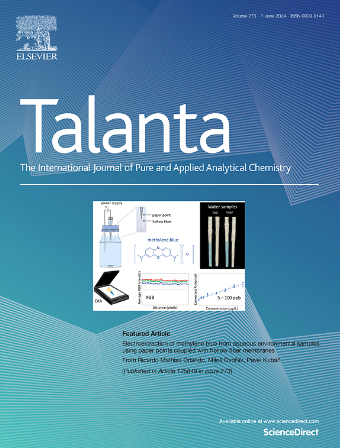Colorimetry/fluorescence dual-signal sensing system based on peptide nanotubes activating hemin and PPIX for sensitive detection of tannic acid
IF 5.6
1区 化学
Q1 CHEMISTRY, ANALYTICAL
引用次数: 0
Abstract
Recently, it has become valuable to develop strategies based on multi-mode sensors to detect analytes related to human health, food safety and environmental pollution. In this study, KL@PPIX-hemin composite prepared by immobilizing hemin and protoporphyrin IX (PPIX) on self-assembled peptide nanotubes (PNTs) through multiple non-covalent interactions were used for colorimetric/fluorescent dual-mode sensing of tannic acid (TA). PNTs as a carrier can provide the hydrophobic microenvironment for hemin and PPIX to protect them from dimerization, thus activating their respective peroxidase-mimicking activity and fluorescence emission. Further experiments show that the composite could catalyze H2O2 to oxidize colorless 3,3′,5,5′-tetramethylbenzidine (TMB) to generate blue ox-TMB, which could exactly quench the emission of PPIX by inner filter effect. The added TA can reduce ox-TMB to TMB and further turn on the fluorescence of system. A colorimetric/fluorescent dual-mode sensing system for TA was thus constructed and a low limit of detection (13.2 nM) was obtained. In addition, the analytical strategy has been successfully applied to accurate TA determination in actual tea samples. The method was also combined with smartphone to achieve visual detection of TA, which provides a broad prospect for portable and rapid tannic acid analysis.

求助全文
约1分钟内获得全文
求助全文
来源期刊

Talanta
化学-分析化学
CiteScore
12.30
自引率
4.90%
发文量
861
审稿时长
29 days
期刊介绍:
Talanta provides a forum for the publication of original research papers, short communications, and critical reviews in all branches of pure and applied analytical chemistry. Papers are evaluated based on established guidelines, including the fundamental nature of the study, scientific novelty, substantial improvement or advantage over existing technology or methods, and demonstrated analytical applicability. Original research papers on fundamental studies, and on novel sensor and instrumentation developments, are encouraged. Novel or improved applications in areas such as clinical and biological chemistry, environmental analysis, geochemistry, materials science and engineering, and analytical platforms for omics development are welcome.
Analytical performance of methods should be determined, including interference and matrix effects, and methods should be validated by comparison with a standard method, or analysis of a certified reference material. Simple spiking recoveries may not be sufficient. The developed method should especially comprise information on selectivity, sensitivity, detection limits, accuracy, and reliability. However, applying official validation or robustness studies to a routine method or technique does not necessarily constitute novelty. Proper statistical treatment of the data should be provided. Relevant literature should be cited, including related publications by the authors, and authors should discuss how their proposed methodology compares with previously reported methods.
 求助内容:
求助内容: 应助结果提醒方式:
应助结果提醒方式:


